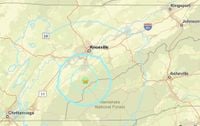A magnitude 4.1 earthquake struck near Greenback, Tennessee, on Saturday morning, May 10, 2025, at 9:04 a.m. Eastern Time, according to the U.S. Geological Survey (USGS). This seismic event, which occurred at a depth of 24.9 kilometers (15.4 miles), was felt widely across North Georgia, Tennessee, and the western Carolinas.
Initially, USGS reported the earthquake as a 3.5 magnitude with a depth of 26.1 kilometers. However, they later upgraded the magnitude and depth after further analysis. The quake was centered approximately 13 miles southeast of Greenback and about 84 miles north of Blairsville, Georgia.
Residents across a broad area reported feeling the tremor, with many taking to social media and local news outlets to share their experiences. Sandy Waltrip from Clarkesville, Georgia, described it as "sounding like someone was stomping on our roof and shaking the house mildly. The squirrels outside were all yelling about it!" Meanwhile, Linda Moseley in Lumpkin County noted that her floor was "vibrating and dishes rattling," reflecting the quake's impact on everyday life.
The earthquake's effects were felt as far away as Maryville, Nashville, Atlanta, Spartanburg, and even southwest Virginia. Radio Greeneville received numerous calls from listeners who reported the quake, indicating its extensive reach. Some reports came from out-of-town listeners, highlighting the tremor's widespread impact.
According to the USGS, earthquakes in the 4.0 to 4.9 magnitude range are classified as "light" on the Richter Scale. These quakes are typically felt by many people and may cause indoor objects to rattle or fall, but they rarely result in significant structural damage. The epicenter of this earthquake was located at coordinates 35.548°N, 83.988°W, with a location uncertainty of 0.2 kilometers horizontally and 0.4 kilometers vertically.
In the aftermath of the quake, experts warned that aftershocks could be possible in the coming days. The USGS advised residents to be prepared for minor tremors that might follow the initial quake. Such aftershocks are common after earthquakes of this magnitude and can vary in intensity.
Reports of the earthquake also came from various communities in North Carolina. Residents in Charlotte, North Carolina, experienced the tremor, with calls pouring into local news stations from areas like South Park, Quail Hollow, and Lincoln County. WCNC Charlotte, a local news outlet, confirmed that viewers reported feeling the quake across these neighborhoods.
As the news of the earthquake spread, social media platforms were abuzz with reactions. Many users shared their experiences, with some expressing surprise and others describing the moment as unsettling. The collective experience of feeling the ground shake brought communities together, as neighbors compared their reactions and the strength of the tremors they felt.
In South Carolina, the earthquake was felt across nearly all viewing areas, from Greenville to Anderson, Oconee, Pickens, and Spartanburg Counties. Reports indicated that the tremor was noticeable, with many residents stating that they felt the ground move beneath them. This cross-state experience highlighted the interconnectedness of the regional response to natural events.
Seismologists noted that while the earthquake was classified as light, it served as a reminder of the geological activity present in the eastern United States. The region, while not known for frequent large earthquakes, is not immune to seismic events. Experts emphasized the importance of earthquake preparedness, encouraging residents to have emergency plans and supplies in place.
The tremor's timing on a Saturday morning meant that many people were awake and alert, leading to a higher likelihood of reports. Had the earthquake occurred during the night, the number of reported experiences might have been lower, as many would have been asleep.
As communities across the affected areas begin to assess the impact of the earthquake, local officials are working to ensure public safety and provide any necessary assistance. Emergency services are on standby, ready to respond to any reports of damage or injuries.
In summary, the magnitude 4.1 earthquake that struck near Greenback, Tennessee, on May 10, 2025, serves as a significant event for the region. With its wide reach felt in multiple states, the quake has prompted discussions about preparedness and the geological realities of living in an area susceptible to seismic activity.
As residents share their stories and the news continues to unfold, it is clear that this earthquake will be remembered as a notable occurrence in the southeastern United States. The community's response and resilience in the face of natural events remain a testament to their strength.





